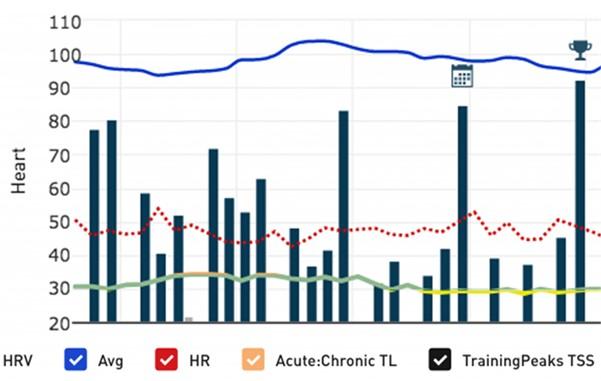Tapering is a period of reduced training leading up to an endurance sports event, with the goal of maximizing performance. The principles of tapering are:
- A gradual reduction in the volume and intensity of training. This helps prevent fatigue, allowing the body to recover and store energy for the big event.
- Maintaining key workouts. Continue to perform important sessions such as interval training or tempo workouts, but at a reduced volume.
- Focusing on nutrition. Eating well during tapering is essential to top performance, as the body needs good quality fuel to perform at its best.
- Mental preparation. Tapering is also a good time to focus on mental preparation, such as visualization and setting race goals.
- Avoiding over-taper. Going too easy during tapering can result in decreased fitness, so it is important to find the right balance between rest and maintaining fitness.
Tapering and the acute:chronic training load ratio
Assuming you have synced your ithlete Pro account with either Garmin Connect or TrainingPeaks, you can use the Acute:Chronic training load ratio to regulate how fast you reduce the load.
Let’s look at an example
The ithlete Pro timeline chart below shows a great example. Daily Training Loads are high, with peak TSS around 200 until 14 days before the competition event (flagged on the right-hand side of the chart). During the more intensive training phase, the acute:chronic line is green, but on the boundary of orange, showing that loads are at the upper end of the low injury risk range. During the last 2 weeks, days of complete rest are interspersed with daily loads of 60-75 TSS, save for a minor race one week out (TSS 220). The acute:chronic line is green bordering on the yellow, which indicates loads are being preserved just high enough to prevent detraining over the short term.
It’s important to maintain some intensity during this phase, so that the sympathetic (fight or flight) branch of the nervous system remains responsive.
Finding the balance
How to get that combination systematically is determined by your tapering strategy. Reducing the volume of training over a 5-7 day period allows the body to recover, rebuild, and renew, increasing your HRV. But if you just stop training completely, the HRV will go up for sure, but your body’s adrenaline making system will also switch off, leaving you feeling sluggish on race day. Many coaches advocate a few high intensity intervals during this time to give the body a ‘short sharp shock’ and thereby keep the fight or flight response primed and ready for action.
Try it now!
Track your HRV with ithlete ready to nail your taper.
You can sign up for a no-obligation 28-day trial below – all you need to do is enter is your email address.

